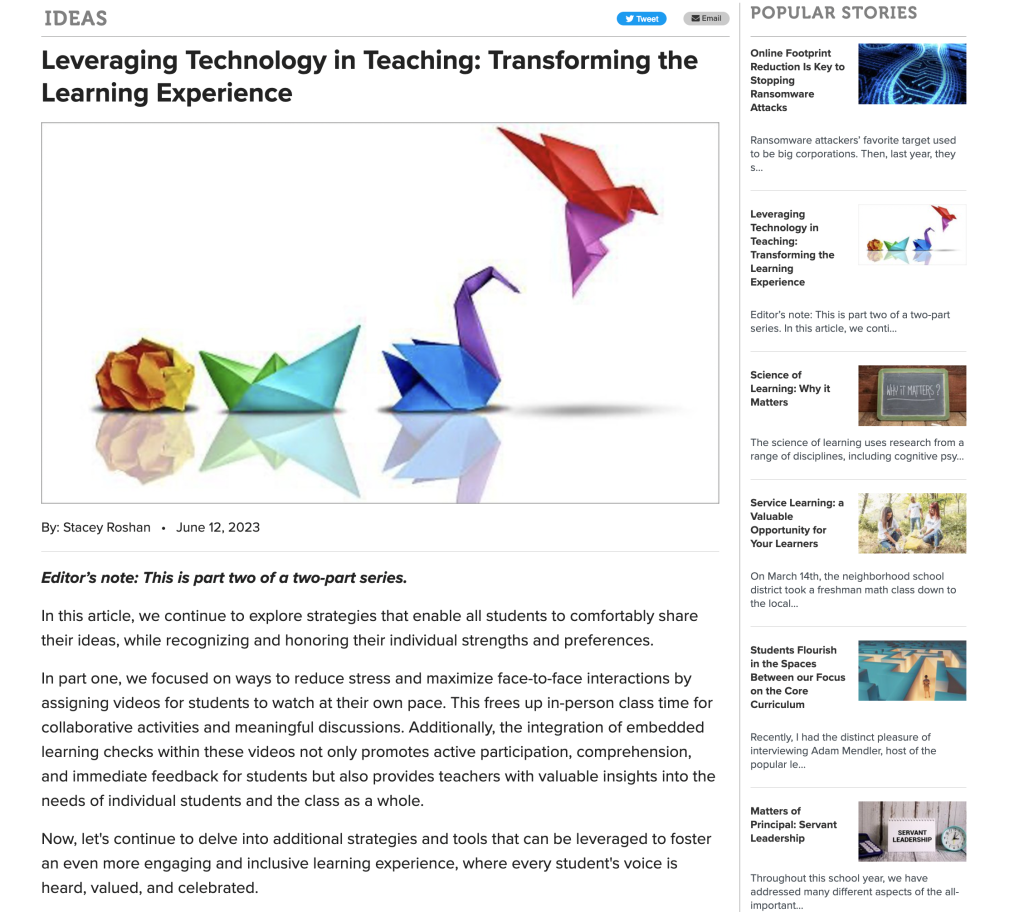This is part two of a two-part series that I had the opportunity to write for The Learning Counsel.
In this article, we continue to explore strategies that enable all students to comfortably share their ideas, while recognizing and honoring their individual strengths and preferences.
In part one, we focused on ways to reduce stress and maximize face-to-face interactions by assigning videos for students to watch at their own pace. This frees up in-person class time for collaborative activities and meaningful discussions. Additionally, the integration of embedded learning checks within these videos not only promotes active participation, comprehension, and immediate feedback for students but also provides teachers with valuable insights into the needs of individual students and the class as a whole.
Now, let’s continue to delve into additional strategies and tools that can be leveraged to foster an even more engaging and inclusive learning experience, where every student’s voice is heard, valued, and celebrated.
Celebrate multiple approaches to a problem and encourage peer-to-peer learning
By asking students to create videos asynchronously, we provide our learners a chance to verbally present and communicate their ideas and understanding of new topics. Apps like Microsoft Flip enable students to record themselves and engage in threaded video discussions with their classmates. This approach not only offers valuable insight into students’ thought processes for teachers but also helps students practice articulating their ideas effectively. Representing all ideas and voices on a grid of replies facilitates powerful peer-to-peer learning and gives teachers unmatched insight into how students are thinking. Listening to students explain how they solved a problem while looking at their written work illuminates where they went wrong in their thinking more clearly than grading written work ever could.
A threaded video discussion platform like Flip enables students to easily record and post their problem-solving approaches. Being able to verbalize a solution requires an added layer of mastery, which is valuable in deepening students’ understanding of the material. Additionally, teachers gain valuable insight into how students are thinking and where they may be getting stuck, allowing them to provide more specific instruction and address any gaps in comprehension. Having students post their solutions to a grid of responses also fosters peer-to-peer learning and celebrates a diversity of strategies to solve similar types of problems.
Providing a safe space for every learner to share
Interactive presentation tools like Pear Deck encourage active participation from all learners. With Pear Deck, teachers embed questions directly into presentations and students can engage and respond using their own devices. Teachers can design comprehensive lessons incorporating opening check-ins, warm-up activities, teacher-led and collaborative discussion prompts, and reflective pauses all within a single tool. During discussions, teachers can present student responses on the board anonymously, instilling confidence among students to share their ideas. By utilizing simple web apps, teachers ensure that every student has a chance to formulate an idea, enabling diverse responses to be represented during discussion.
In my math classroom, I use the drawing feature in Pear Deck, paired with a class set of Wacom tablets, which puts a digital pen in the hand of each student. Students plug the Wacoms into their laptops and then are free to handwrite their responses to questions as they would on a piece of paper.
These tools combined give teachers a dashboard view of all students working on problems in real time. Instead of just turning in a page of completed work, teachers can observe students as they work. Teachers can see where a student might hesitate or struggle, get stuck, the moment they go astray, and also witness and anonymously spotlight creative solutions alongside common misconceptions. In doing so, we can celebrate the variety of ways students are thinking about problems and normalize mistakes as part of the learning journey without singling anyone out.
